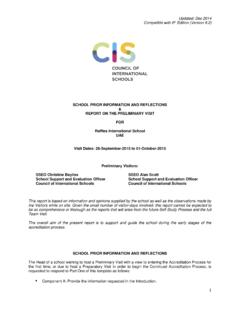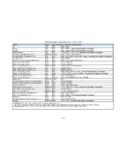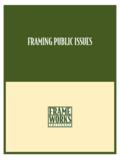Transcription of Why Teach Probability in the Elementary Classroom
1 Why Teach Probability in the Elementary Classroom ? Felicia M. Taylor Abstract While the curriculum in the United States continues to focus on basic skills well past the fourth grade, classrooms in Japan and Germany emphasize more advanced concepts--including algebra, geometry, and Probability (Riley, 1998). If the aim of the United States is to be first in science and mathematics, teachers may need to introduce children to Probability at earlier grade levels. Introduction In the Principles and Standards, emphasis is placed on introducing the same topics and concepts throughout the Pre K-12 curriculum a spiral curriculum. A spiral curriculum begins with fundamentals that children already have learned and builds upon them by adding more complex and subtle categories and methods. Young children need to explore the process of Probability . The study of Probability in the early grades provides a stronger foundation for high school students (NCTM, 2000).
2 Bruner (1960) stated in his discussion of the spiral curriculum, If the understanding of number, measure, and Probability is judged crucial in the pursuit of science, then instruction in these subjects should begin as intellectually honestly and as early as possible in a manner consistent with the child's forms of thought. Let the topics be developed and redeveloped in later grades. (pp. 53-54). He also believed, If one respects the ways of thought of the growing child, if one is courteous enough to translate material into his logical forms and challenging enough to tempt him to advance, then it is possible to introduce him at an early age to the ideas and styles that in later life make an educated man. (p. 52). This rationale should encourage teaching of experimental Probability concepts beginning in the Elementary grades. In addition, the study of Probability allows learners to make sense of experiences involving chance.
3 Probability "As with other beautiful and useful areas of mathematics, Probability has in practice only a limited place in even secondary school instruction" (Moore, 1990, p. 119). The development of students' mathematical reasoning through the study of Probability is essential in daily life. Probability represents real-life mathematics. Probability also connects many areas of mathematics, particularly counting and geometry (NCTM, 1989). "Research in medicine and the social sciences can often be understood only through statistical methods that have grown out of Probability theory" (Huff, 1959, p. 11). Moore (1990) stated, Probability is the branch of mathematics that describes randomness. The conflict between Probability theory and students' view of the world is due at least in part to students' limited contact with randomness. We must therefore prepare the way for the study of chance by providing experience with random behavior early in the mathematics curriculum.
4 (p. 98). An understanding of Probability theory is essential to understand such things as politics, weather reports, genetics, sports, and insurance policies. As shown Table 1, the list of questions presented in the different areas shows the need for experimental Probability . Experimental Probability is the actual results of an experiment or trial. These questions require considerations of probabilities and what they mean (Huff, 1959). Table 1. Real Life Mathematics Using Experimental Probability Example Description Politics A random survey of voters show that 381 out of 952 are planning to vote for Candidate McCain in the primary election. What is the Probability that a randomly selected voter will vote for Candidate McCain? Weather Reports The Probability of rain today is 70%. What are the odds in favor of rain? What are the odds against rain? Genetics In genetics, we can use Probability to estimate the likelihood of a family with two children having one boy and one girl.
5 What is the chance that a family with two children will have one boy and one girl? Survey the students in school and record the family composition of all families with two children. Simulate the situation tossing two coins an equal amount of times as the number of students surveyed in the school to determine the Probability of a family with two children having one boy and one girl. Sports Softball statistics (NCTM, 1989, p. 111). H o m e ru n s 9. T r ip le s 2. D o u b le s 1 6. S in g le s 2 4. W a lk s 1 1. O u ts 3 8. T o ta l 1 0 0. Above is the record of a player's last 100 times at bat during the softball season. What is the Probability the player will get a home run? What is the Probability that the player will get a hit? Insurance Policies Motor insurance companies use the principle of Probability to determine how many customers will make a claim in a given year.
6 One way of figuring out how many customers will make a claim is by looking at previous data to try and predict future claims. Using teachers, administrators and staff, determine the Probability of someone making a claim this year. Survey the teachers, administrators and staff to determine how many claims were made in the previous year. Compare your results. The inclusion of activities dealing with experimental Probability in the Elementary school enhances children's problem-solving skills and provides variety and challenges for children in a mathematics program (Kennedy & Tipps, 1994). Current and past recommendations for the mathematics curriculum identify experimental Probability as one of several critical basic skill areas that should occupy a more prominent place in the school curricula than in the past (National Council for Supervisor of Mathematics (NCSM), 1989; Mathematical Sciences Education Board [MSEB], 1990; Willoughby, 1990; NCTM, 2000).
7 Unfortunately, many schools fail to introduce Probability until the end of the school year or not at all. From a historical perspective, members of the Cambridge Conference on School Mathematics (1963) also acknowledged the role Probability and statistics played in our society. The Cambridge Conference was an informal discussion of the condition of the mathematics curriculum in the United States at the Elementary and secondary level. The members of the conference addressed revisions to the mathematics curriculum. They recommended that Probability and statistics not only be included as part of the modern mathematics of that day, but these were also recommendations that they considered for 1990 and 2000. Other researchers have suggested that elements of statistics and Probability be introduced in the secondary school curriculum and possibly at the Elementary level as part of the basic literacy in mathematics that all citizens in society should have (Schaeffer, 1984; Swift, 1982).
8 Changes are being made today to introduce Probability into the Elementary school curriculum (NCTM, 2000). Experience with Probability can contribute to students' conceptual knowledge of working with data and chance (Pugalee, 1999). This experience involves two types of Probability --theoretical and experimental. There may be a need for students to be exposed to more theoretical models involving Probability . Theoretical models organize the possible outcomes of a simple experiment. Some examples of theoretical models may include making charts, tree diagrams, a list, or using simple counting procedures. For example, when asked to determine how many times an even number will appear on a die rolled 20 times, students can list the ways of getting an even number on a die (2, 4, 6) and may conclude that one should expect an even number one-half of the time when a die is rolled.
9 Then, students can roll the die 20 times, record their actual results and make conclusions based on their experiment. Another example that involves experimental modeling is the following: If you are making a batch of 6 cookies from a mix into which you randomly drop 10 chocolate chips, what is the Probability that you will get a cookie with at least 3 chips? Students can simulate which cookies get chips by rolling a die 10 times. Each roll of the die determines which cookie gets a chip. (NCTM, 1989, pp. 110-111). The most important use of Probability is to help us make decisions as we go through life (Newman, Obremski, & Schaeffer, 1987). For example, in issues of fairness, students may pose a question based on claims of a commercial product, such as which brand of batteries last longer than another (NCTM, 2000). Benefits of Probability Knowledge in Early and Later Grades The committee for the Goal for School Mathematics, the report of the 1963 Cambridge Conference, recommended introducing basic ideas of Probability very early in the school program.
10 The study of Probability allows a learner to make sense of experiences involving chance. As previously mentioned in the Introduction, Bruner (1960) believed that by constantly reexamining material taught in Elementary and secondary schools for its fundamental character, one is able to narrow the gap between advanced knowledge and Elementary knowledge. Bruner said that if you wish to Teach calculus in the eighth grade, then begin in the first grade by teaching the kinds of ideas and skills necessary for the mastery of calculus in later years. This is one of the changes made in the Principles and Standards--to include the same concepts throughout all grade levels, teaching necessary skills appropriate at that grade level, and continuing at each grade level. Bruner believed concepts should be revisited at increasing levels of complexity as students move through the curriculum rather than encountering a topic only once (Schunk, 1991).









